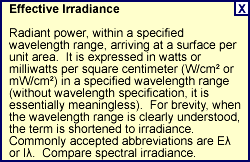Guide to UV Measurement
UV Exposure: Irradiance, Spectral Distribution and Energy
There are four key factors of UV exposure that affect the curing and the consequent performance of the UV curable material. Simply stated, these are the minimum exposure parameters that are required to sufficiently define the process:
- irradiance -- either peak or profile of radiant power arriving at a surface, measured in W/cm² or mW/cm²;
- spectral distribution – relative radiant power versus wavelength in nanometers (nm);
- time (or 'speed') – energy is the time-integral of irradiance measured in J/cm² or mJ/cm², and
- infrared (IR) or heat – usually observed by the temperature rise of the substrate, °F or C.
(A non-contacting optical thermometer is recommended for surface temperature measurement). (For more on temperature measurements, see “Temperature Measurements Under UV Lamps”.
Irradiance data must always include identification of the wavelength range to which it applies. This is one of the most common omissions in radiometry. When irradiance is measured in any specific range of wavelengths, it is called "effective irradiance". When this wavelength range is clearly understood, the term "irradiance" is sufficient. ("Intensity" is not a technically defined term, but is commonly but improperly used to mean irradiance). Peak irradiance has a distinct effect and benefit on speed and depth of cure. Irradiance levels in 3-D curing are typically much lower than in flat linear curing.
|
As with irradiance, when the wavelength range is clearly stated, and it is clear that the meaning is "per unit area," this term can be simply abbreviated as "energy."
Information about irradiance or of the entire exposure profile is important to the design. The fact that different irradiance profiles can produce different physical properties in most UV-curable materials is the reason that profile information is needed in the process design stage. The exposure profile is characteristic of any lamp design and, in multi-lamp 3-D applications, the lamp positioning and organization.
A measurement of total UV energy is a composite of irradiance profile and velocity, but information about neither irradiance, profile, nor time can be extracted from it. Consequently, data on energy alone is less important to design, but can be useful in monitoring or control.
